
The No. 8 Hose Station is a small fire hall that is a Toronto landmark. It is located on College Street at Bellevue and marks the northern end of Kensington Market and serves the Chinatown area at Spadina and Dundas.

The No. 8 Hose Station is a small fire hall that is a Toronto landmark. It is located on College Street at Bellevue and marks the northern end of Kensington Market and serves the Chinatown area at Spadina and Dundas.
The hall was built in 1878 as part of the transformation of the Toronto Fire Department that saw it move from a volunteer to a professional organization. The station was home to horse drawn hose car. The clock tower, that quickly became a symbol of the neighbourhood, was added in 1899. From the top of the tower a lookout would watch for fires. It was also useful for hanging hoses to dry. In 1911 it received the city's first motorized fire engine.
In the 1960s most of the old fire houses were demolished, but community pressure saved the firehall. The building was being renovated and the hall’s firecrew were moved to another firehall about two weeks before the 28 May 1972 fire. [1] Arson was suspected and destroyed the tower’s wooden and copper roof, melted the clock, but left the brickwork relatively undamaged. [1] Again the community assured its survival and the building was rebuilt almost exactly as it had been before. [2] The addition that stored the aerial ladder was replaced with the modern 3 bay addition that now houses the station's trucks.

St. Lawrence is a neighbourhood located in downtown Toronto, Ontario, Canada. The area, a former industrial area, is bounded by Yonge, Front, and Parliament Streets, and the Canadian National railway embankment. The Esplanade off Yonge St., lined with restaurants, cafés and hotels runs through the middle of the area. In previous times, the area was sometimes referred to as 'St. Lawrence Ward' or more often today as 'St. Lawrence Market', synonymous with the large retail vendor market which is the neighbourhood's focal point. The area is the site of a large city-sponsored housing project of the 1970s, which revitalized an old brownfields area. The boundaries of the St Lawrence Neighbourhood Association and the St Lawrence Market BIA are somewhat larger than those noted above. Both groups have boundaries that extend from Yonge to Parliament Streets and Queen Street East to the rail corridor.
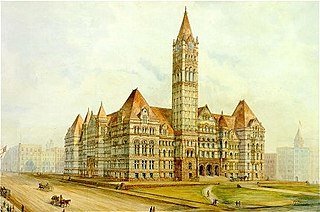
The Great Fire of Toronto of 1904 destroyed a large section of Downtown Toronto, Ontario, Canada on April 19, 1904. It was the second such fire for the city in its history.

CFRB is a commercial AM radio station in Toronto, Ontario, Canada. It is owned by Bell Media and carries a News/Talk radio format. Its studios and offices are in the Entertainment District at 250 Richmond Street West.

The Old City Hall is a Romanesque-style civic building and former court house in Toronto, Ontario, Canada. It was the home of the Toronto City Council from 1899 to 1966 and a provincial court house until 2023, and remains one of the city's most prominent structures.

CHBM-FM is a radio station in Toronto, Ontario, Canada broadcasting at 97.3 FM. The station currently broadcasts a classic hits format branded as Boom 97.3. CHBM's studios are located at Yonge Street and St. Clair Avenue in Toronto's Deer Park neighbourhood, while their transmitter is located atop the CN Tower. The station is owned by the Stingray Group.
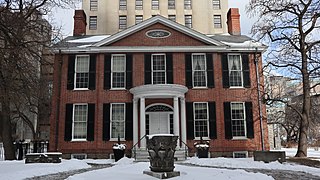
Campbell House is an 1822 heritage house and museum in downtown Toronto, Ontario, Canada. It was built for Upper Canada Chief Justice Sir William Campbell and his wife Hannah. The home was designed for entertaining and comfort, and constructed at a time when the Campbells were socially and economically established and their children had grown to adulthood. The house is one of the few remaining examples of Georgian architecture left in Toronto and is constructed in a style in vogue during the late Georgian era known as Palladian architecture.

The Jefferson Market Branch of the New York Public Library, once known as the Jefferson Market Courthouse, is a National Historic Landmark located at 425 Avenue of the Americas, on the southwest corner of West 10th Street, in Greenwich Village, Manhattan, New York City, on a triangular plot formed by Greenwich Avenue and West 10th Street. It was originally built as the Third Judicial District Courthouse from 1874 to 1877, and was designed by architect Frederick Clarke Withers of the firm of Vaux and Withers.

Queen's Quay Terminal is a condominium apartment, office and retail complex in the Harbourfront neighbourhood in Toronto, Ontario, Canada. It was originally built in 1927 as a marine terminal with office, warehouse and cold-storage facilities. When shipping to Toronto declined in the 1960s and 1970s, the building was bought by the Government of Canada to be repurposed along with a section of the industrial waterfront. The Terminal Building itself was rebuilt in the 1980s with the addition of four floors of residential above the original facility, which was converted into retail and office uses. The cold storage wing was demolished and its plant building became The Power Plant gallery and Harbourfront Centre Theatre.
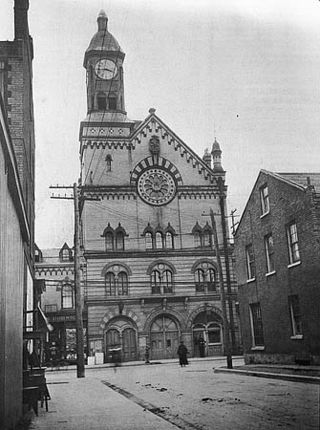
Yorkville Town Hall was the municipal building for the Village of Yorkville before its annexation by the City of Toronto. Built in 1859-1860 by architect William Hay and his apprentice Henry Langley, the three-storey building also served as an omnibus stop. The hall was located north of Bloor Street on Yonge Street, along the west side.

The Broadview Hotel is a 58 room boutique hotel in Toronto, Ontario, Canada. It is located at the intersection of Broadview Avenue and Queen Street East in Toronto's Riverside neighbourhood. Built in 1893, the building was originally a hall with retail and office space and later converted into a hotel. Until 2014, the establishment was occupied by the New Broadview House Hotel, a hotel and boarding house housing low-income persons with a strip club named Jilly's on its ground level. It was closed and converted to an up-scale establishment with several restaurants and a roof patio.

Portsmouth Guildhall is a multi-use building in the centre of Portsmouth, Hampshire, England. It is located in a pedestrian square close to Portsmouth and Southsea railway station. Constructed in 1890, the building was known as Portsmouth Town Hall until 1926. It was heavily damaged by bombing during the Second World War and largely rebuilt during the 1950s by the English architect Ernest Berry Webber. It now operates as a concert, wedding and conference venue. It is a Grade II listed building.

Concord Park Place is a 45-acre (18 ha) multi-tower condominium complex under construction by developer Concord Adex in Toronto, Ontario.
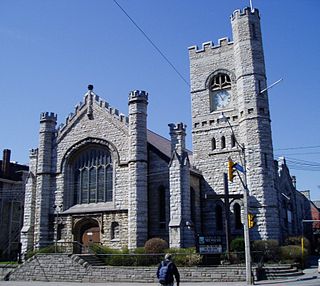
The Church of the Messiah is an Anglican church in Toronto, Ontario, Canada. It is located at 240 Avenue Road, on the corner of Dupont Street. The church was founded on March 24, 1891, by members of the Church of the Redeemer further south on Avenue Road. The building was designed by Gordon & Helliwell, along with a rectory next door.

Brampton City Hall is home to Brampton City Council and the departments of the city. It is located at the intersection of Wellington Street and Main Street in downtown Brampton.

The Alumnae Theatre, known most often as The Alum, is the oldest theatre society in Toronto, Ontario, Canada still in operation. It was founded in 1918 by female graduates of the University of Toronto who wanted to continue to participate in semi-professional theatre after graduation. Originally all performers in all roles were female, but in the 1920s the society began to invite male guest performers to join the performances. Still today the leadership of the society remains entirely female.
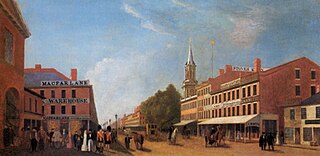
The Great Fire of Toronto of 1849, April 7, 1849, also known as the Cathedral Fire, was the first major fire in the history of Toronto, Ontario, Canada. Much of the Market Block, the business core of the city, was wiped out, including the predecessor of the current St. James Cathedral. The 1831 building of the Toronto City Hall and St. Lawrence Market south of King was damaged and was torn down.

A hose tower is a structure constructed for hanging firehoses to dry. Hose towers have been features of some fire station designs in Canada, Germany, and the United States. The purpose of such towers was to hang and dry canvas hoses, slowing the deterioration caused if the hoses were not dried thoroughly. Fire stations can also have towers for other purposes: a clock tower or bell tower or drill tower for firemen to practice. In Australia, especially, some fire stations had watch towers for looking for smoke, presumably in relatively flat areas and in spread out low towns where an extra story or two of elevation provided for an extremely wide range of vision, perhaps 360 degrees. Before radio/telephone communications, in the U.S. and Australia and elsewhere, fire lookout towers were also sited on mountain tops or other remote locations with wide views, later, when radio/telephone communications were possible.